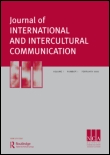
Journal of International and Intercultural Communication
Scope & Guideline
Transforming International Dialogue through Research
Introduction
Aims and Scopes
- Intercultural Communication Theory:
The journal provides a platform for the development and examination of theories related to intercultural communication, addressing how communication practices vary across different cultural settings. - Identity and Cultural Negotiation:
A significant focus is placed on how individuals negotiate their identities within multicultural environments, particularly in contexts of migration, diaspora, and globalization. - Social Justice and Equity:
The journal emphasizes themes of social justice, equity, and representation, exploring how communication practices can either reinforce or challenge systemic inequalities. - Methodological Diversity:
The journal encourages the use of diverse methodological approaches, including qualitative, quantitative, and mixed-methods research, to provide a comprehensive understanding of intercultural dynamics. - Cultural Resistance and Transformation:
Research often examines how cultural practices and communication serve as forms of resistance against oppressive structures, highlighting the role of communication in social change.
Trending and Emerging
- Decolonial Approaches:
Recent publications highlight the importance of decolonial perspectives in communication studies, examining how colonial histories shape current intercultural interactions and communication practices. - Digital Communication and Social Media:
The impact of digital platforms on intercultural communication is increasingly prominent, exploring how social media shapes identity, activism, and cultural exchange. - Racialization and Ethnic Identity:
There is a growing focus on the complexities of racialization and ethnic identity, particularly in the context of migration and diaspora, reflecting wider societal discussions on race and identity. - Health Communication in Multicultural Contexts:
Emerging studies on health communication address disparities and cultural factors affecting health outcomes, particularly in immigrant and marginalized communities. - Intersectionality in Communication:
The journal is increasingly exploring intersectional frameworks that consider how various social identities (e.g., race, gender, sexuality) intersect to influence communication practices and experiences.
Declining or Waning
- Traditional Cross-Cultural Comparisons:
There appears to be a decrease in studies that focus solely on traditional cross-cultural comparisons, as the journal leans more towards intersectional and nuanced discussions of identity and power dynamics. - Generalized Cultural Studies:
Research that broadly addresses cultural phenomena without specific intercultural communication implications seems to be waning, with a shift towards more targeted and relevant discussions. - Focus on Homogenous Cultural Groups:
There is a noticeable decline in papers that examine communication within homogeneous cultural groups, suggesting a growing emphasis on the complexities of multicultural interactions.
Similar Journals
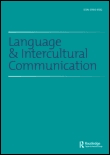
Language and Intercultural Communication
Unpacking the Power of Language in Intercultural SpacesLanguage and Intercultural Communication is a leading peer-reviewed journal published by Routledge Journals, Taylor & Francis Ltd, based in the United Kingdom. With an ISSN of 1470-8477 and an E-ISSN of 1747-759X, this esteemed publication has established itself as a vital resource in the fields of Communication and Linguistics, boasting an impressive Q1 classification in both categories as of 2023. The journal's scope encompasses a broad range of topics related to language and its role in intercultural contexts, making it an essential platform for researchers, professionals, and students alike who wish to contribute to and learn from the latest scholarly discussions. Even without an open-access option, its high impact factor and strong Scopus rankings, which place it in the 87th percentile for Linguistics and Language, affirm its significance in shaping contemporary dialogue. As we move towards 2024, Language and Intercultural Communication continues to foster academic exchanges that challenge, expand, and enrich understanding across diverse linguistic and cultural landscapes, making it a must-read for anyone interested in the intersection of language and culture.

Frontiers in Communication
Catalyzing Collaboration Across Communication FrontiersFrontiers in Communication is a prestigious open-access journal published by FRONTIERS MEDIA SA, dedicated to advancing the field of communication studies. Established in 2016 and situated in Switzerland, this journal has quickly ascended to notable ranks, achieving a Q1 category in both Communication and Social Sciences (miscellaneous) as of 2023. With an impressive Scopus rank, positioning it in the 75th and 78th percentiles for its respective categories, Frontiers in Communication serves as a vital platform for innovative research, interdisciplinary dialogue, and the dissemination of knowledge in the rapidly evolving landscape of communication. The journal emphasizes accessibility and intellectual exchange, providing an open-access format that ensures unrestricted access for researchers, professionals, and students alike. By fostering collaboration and exploration across various communication frameworks, Frontiers in Communication plays a crucial role in shaping the future discourse within the field.
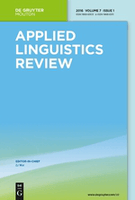
Applied Linguistics Review
Advancing the frontiers of language research.Applied Linguistics Review is a leading academic journal published by WALTER DE GRUYTER GMBH, focusing on the dynamic field of linguistics and language studies. With an impressive Q1 quartile ranking in both Linguistics and Language and Social Sciences, the journal positions itself at the forefront of research, making it a crucial resource for scholars and professionals alike. The journal aims to foster scholarly dialogue by publishing high-quality, peer-reviewed articles that explore theoretical frameworks, empirical studies, and innovative methodologies in applied linguistics. Operating from Poland with an international reach, it is committed to advancing knowledge in areas such as language acquisition, language policy, and multilingualism. Its notable performance can be seen in its Scopus rankings, where it stands at #72 out of 1088 in the Arts and Humanities category and #86 out of 1167 in Social Sciences. The Applied Linguistics Review serves as an invaluable platform for researchers, educators, and students to disseminate and engage with cutting-edge research, thereby enhancing their understanding and application of linguistic principles in diverse contexts.
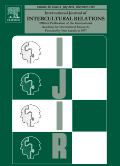
International Journal of Intercultural Relations
Connecting Cultures Through Cutting-Edge ResearchWelcome to the International Journal of Intercultural Relations, a premier publication dedicated to advancing the field of intercultural studies. Published by Pergamon-Elsevier Science Ltd in the United Kingdom, this journal has established itself as a vital resource for researchers and practitioners focusing on the complexities of cultural interactions across the globe. With an impressive impact factor reflecting its significance—ranked in Q1 for Business and International Management and Sociology and Political Science, and Q2 for Social Psychology—this journal strives to deliver cutting-edge research that informs and influences policy and practice in a multicultural world. Since its inception in 1977, the journal has provided a platform for interdisciplinary discourse and empirical studies, ensuring that the voices of diverse cultures are heard and understood. Researchers, professionals, and students engaged in intercultural relations will find valuable insights and methodologies that tackle contemporary challenges in this vital area of study. Join us as we explore the nuances of human interaction within a globalized society.

Intercultural Pragmatics
Bridging Cultures Through Communication.Intercultural Pragmatics, published by De Gruyter Mouton in Germany, stands at the forefront of the study of communication across diverse cultures, bridging the gap between linguistic theory and real-world intercultural exchanges. With an ISSN of 1612-295X and an E-ISSN of 1613-365X, this esteemed journal has been contributing to the field since its inception in 2004, showcasing rigorous scholarship through its convergence of literature up to 2024. The journal enjoys a commendable reputation, positioned in the Q2 quartile of Communication and the Q1 quartile of Linguistics and Language, reflecting its significant impact within the academic community. As recognized in Scopus rankings, it is ranked #122 out of 1088 in Arts and Humanities (Language and Linguistics) and holds an impressive 88th percentile, making it an essential resource for researchers, professionals, and students eager to deepen their understanding of intercultural dynamics. While access options remain standard, the journal prioritizes groundbreaking insights and theoretical advancements that contribute to the ever-evolving landscape of linguistics and intercultural communication.
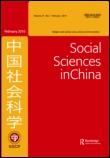
Social Sciences in China
Exploring China's Social LandscapeSocial Sciences in China is a leading academic journal published by Routledge Journals, Taylor & Francis Ltd, focusing on the vast and dynamic field of social sciences as they pertain to the Chinese context. With an ISSN of 0252-9203 and an E-ISSN of 1940-5952, this journal offers a platform for scholars to present empirical research, theoretical explorations, and impactful discourse on societal issues, cultural transformations, and political developments in China. Established in 1980, Social Sciences in China has evolved to become a vital resource, despite being categorized in the Q4 quartile of Social Sciences (miscellaneous) and ranking in the 38th percentile of its domain according to Scopus. This journal reflects the ongoing discourse in the field and is invaluable for researchers, professionals, and students seeking to understand or contribute to the rapidly changing social landscape of China. The journal is committed to maintaining high publication standards and aims to foster interdisciplinary dialogue and collaboration among social scientists worldwide.

Yazyk i Kultura-Language and Culture
Unraveling Linguistic Threads in Cultural TapestriesYazyk i Kultura - Language and Culture is a distinguished academic journal dedicated to the exploration of linguistic and cultural issues across various contexts. Published by TOMSK STATE UNIVERSITY, this journal serves as a vital resource for researchers, scholars, and students interested in the intricate interplay between language and culture. With an ISSN of 1999-6195 and an E-ISSN of 2311-3235, it engages a global community in disseminating high-quality research articles, reviews, and theoretical discussions. Although the journal is not categorized as Open Access, it ensures that its contents contribute significantly to the academic discourse within the fields of linguistics, cultural studies, and social sciences. With a commitment to promoting scholarly research, Yazyk i Kultura is positioned to shape contemporary conversations about language's role in cultural dynamics, making it an essential outlet for those dedicated to advancing understanding in this interdisciplinary domain.
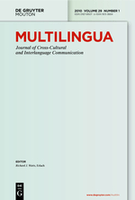
Multilingua-Journal of Cross-Cultural and Interlanguage Communication
Connecting Scholars in the Realm of MultilingualismMultilingua: Journal of Cross-Cultural and Interlanguage Communication is a premier academic journal published by DE GRUYTER MOUTON, specializing in the dynamic fields of communication and linguistics. Established in 1982, this journal has significantly contributed to the discourse surrounding multilingualism, intercultural interactions, and language acquisition, with a notable reputation backed by an impressive Q1 ranking in both Communication and Linguistics and Language for 2023. Positioned strategically at the heart of Germany, the journal serves as a vital platform for researchers, professionals, and students alike, fostering scholarly exchange and insights into cross-cultural communication practices. With rankings placing it in the top percentiles across key categories in Scopus, including Arts and Humanities and Social Sciences, Multilingua exemplifies the highest standards of academic excellence. Although currently not an Open Access journal, it continues to provide a wealth of knowledge to the global research community.

Suvremena Lingvistika
Illuminating the Complexities of Language and Communication.Suvremena Lingvistika is a distinguished open-access journal published by the Croatian Philological Society, dedicated to advancing research in the field of linguistics and language. Since its establishment, the journal has been pivotal in promoting scholarly dialogue within the linguistics community, especially among researchers and academics in Croatia and beyond. With an ISSN of 0586-0296 and an E-ISSN of 1847-117X, the journal has transitioned to an open-access model since 2007, ensuring that research is freely accessible to all. As of 2023, it holds a respectable Q3 ranking in the Linguistics and Language category, reflecting its potential contribution to the field. The journal's scope encompasses a wide array of linguistic disciplines, encouraging both theoretical and empirical studies. Supportive of new research, Suvremena Lingvistika aims to foster innovative approaches and methodologies in linguistics, making it an essential resource for students, researchers, and professionals eager to explore the complexities of language. With its ongoing publication until 2024, it continues to shape the linguistic landscape, providing valuable insights and fostering collaboration among scholars globally.
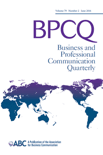
Business and Professional Communication Quarterly
Advancing Insights in Professional Communication.Business and Professional Communication Quarterly, published by SAGE Publications Inc., stands as a vital resource in the fields of business communication and professional interaction. With an ISSN of 2329-4906 and an E-ISSN of 2329-4922, this journal serves as a platform for scholars and practitioners to explore the nuances of communication within various business contexts. It holds an impressive Q2 ranking in the Arts and Humanities category and features prominently in several other relevant categories, as evidenced by its competitive Scopus rankings. Covering a broad scope from 2015 to 2024, the journal offers insights into innovative communication strategies, best practices, and emerging trends that resonate with both academic and practical audiences. Although not an open-access journal, the accessibility of its well-researched articles ensures that valuable knowledge is available to those invested in enhancing business communication methodologies. The journal is instrumental for researchers, professionals, and students aiming to advance their understanding of effective communication in the professional landscape, thus contributing to the discourse on best practices in this essential area.